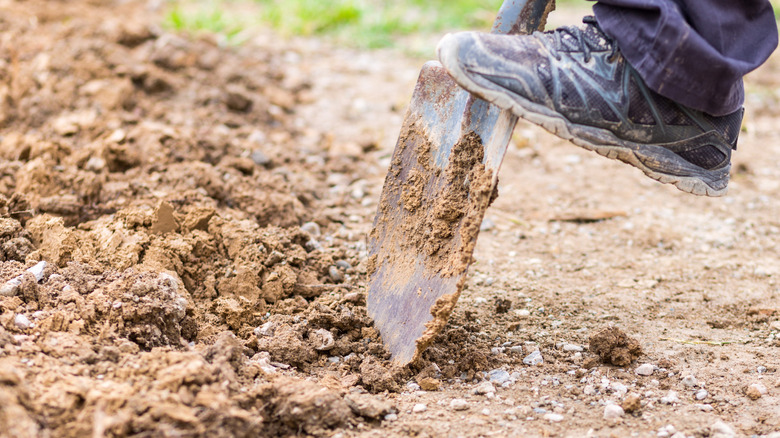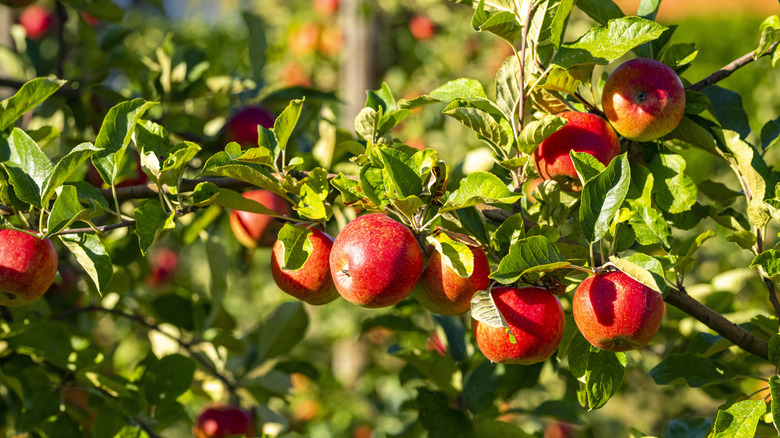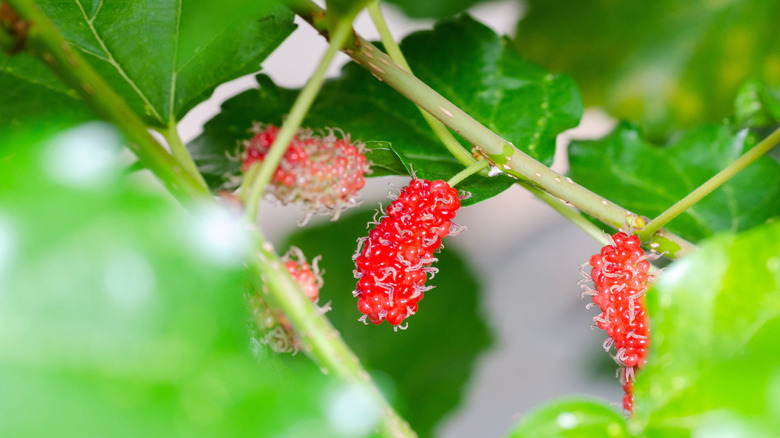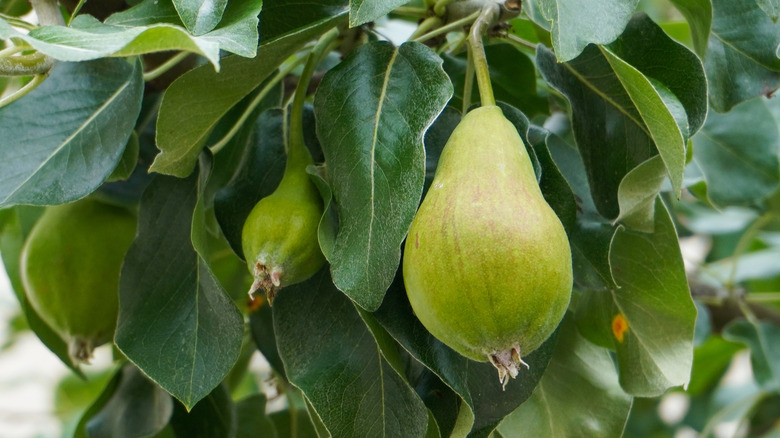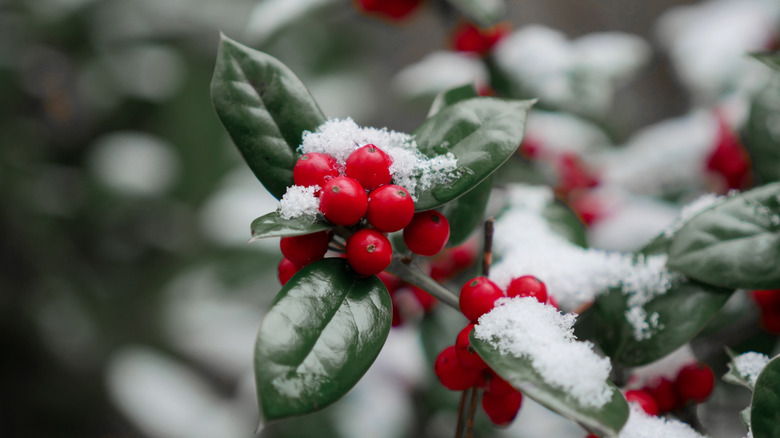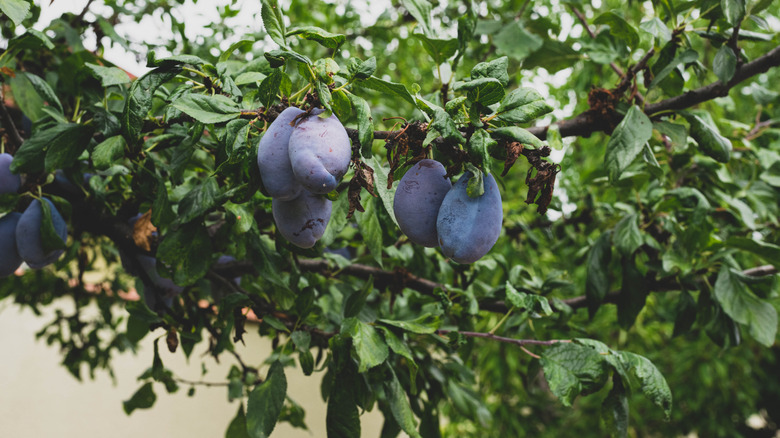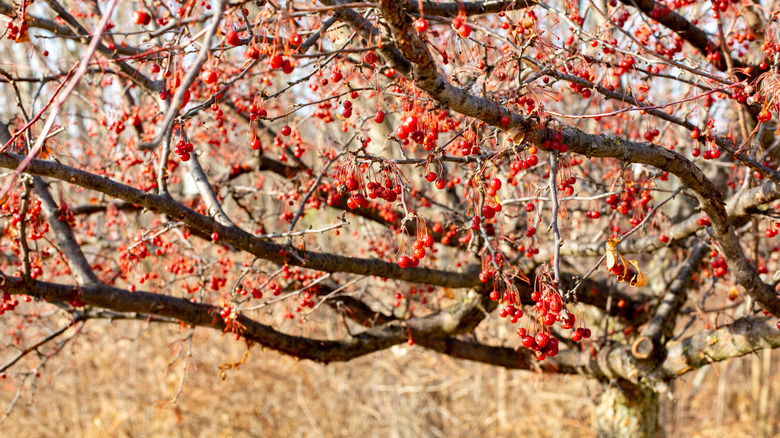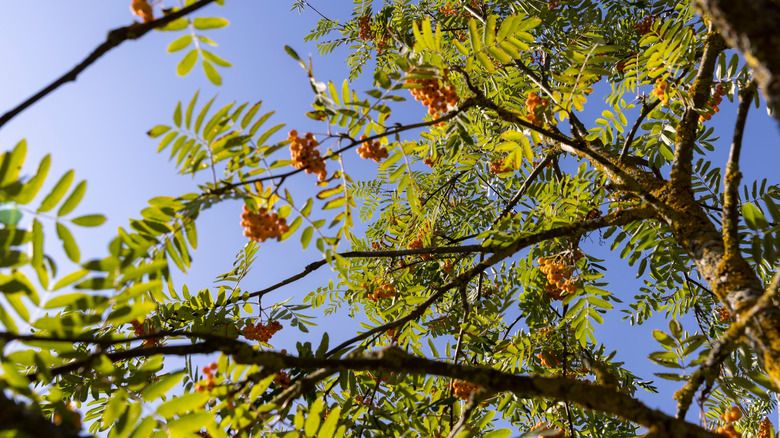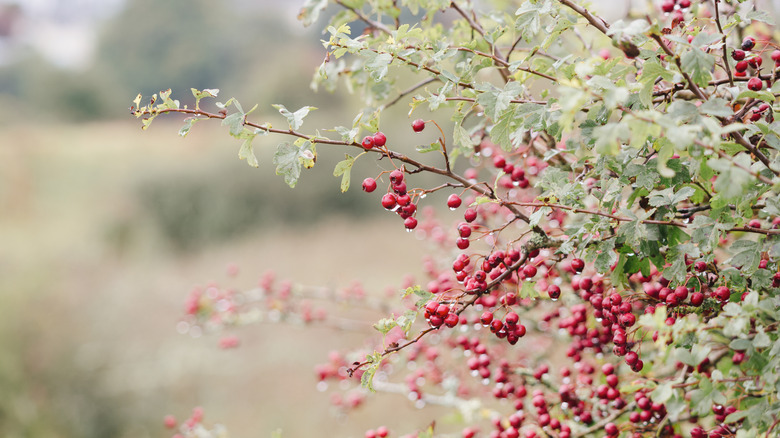8 Captivating Fruit Trees And Bushes That Will Thrive In Clay Soil
Hopeful gardeners who dig into a new patch of soil only to find thick curls of clay can feel their hope slip away in seconds. Clay, or heavy soil, is infamous in the world of gardening. When saturated after periods of heavy rain, clay does not drain well. Conversely, during dry spells, it forms a tough surface for water to penetrate, depriving the roots of moisture.
That said, clay soils offer certain benefits to plants. Despite restricting air and moisture movement, they retain both nutrients and water well, and there are plenty of beautiful plants that thrive in clay soil. Fruit-bearing plants aren't usually among these, but some fruit trees and bushes can eke out enough necessities from this thick medium to grow into healthy specimens and provide eventual edibles to humans and wildlife. We've assembled a list of the most striking clay-tolerant fruit trees and bushes. Among them, you'll discover varieties of apple, pear, plum, hawthorn, holly, and many more.
While the collection in our lineup will take to clay soils, improving heavy clay soil in your garden with the help of amendments like gypsum or rotted compost and manure can lead to better growth. To give your trees and bushes a leg up when you're planting them in clay soil, score the walls of your hole with a shovel or another tool. This way, the roots can work their way into the tough stuff with a little less effort.
Apple
Many, but not all, varieties of apple (Malus spp.) are well-suited to clay soils. 'Honeycrisp', 'Fuji', 'Gala', 'Granny smith', and 'Liberty' are all tasty candidates for clay soils. Crabapple — the only species of apple native to North America — also tolerates this type of soil. You may not grow them for their fruit, but these trees are wildlife magnets. Insect pollinators visit the blossom buffet in spring, and both birds and deer feast on the fruits that eventually emerge.
Red mulberry
Red mulberry (Morus rubra) is a North American native that makes the most of clay soils mainly in the eastern half of the continent. This bird-attracting tree is also beloved by mammals. Beware the white mulberry, though. This native of China has become invasive in a number or eastern and southeastern states, where it's a threat to local ecosystems, including the red mulberry. Red mulberry trees are hardy in zones 4 to 10.
Pear
Pear trees (Pyrus spp.) stand out as particularly amenable to clay soil. The common pear (Pyrus communis) performs best when there are a few other varieties planted nearby, and is hardy in zones 5 to 8. Although they are native to Europe and parts of Asia, most varieties grow in North America without becoming invasive. One exception is the 'Bradford' pear, also known as callery pear (Pyrus calleryana 'Bradford'), which is invasive in numerous U.S. states.
Holly
No matter the species, holly (Ilex) is evocative of the festive season. This evergreen tree, with spiky, glossy leaves and brilliant berries, tolerates clay soils like a champ, no matter the species. You can't go wrong with American holly, but note that both English and Japanese hollies are invasive in Oregon and Virginia. These evergreen trees hold berries through the winter, providing an energizing snack for birds. However, to produce fruit, plant both a male and female tree. American holly is hardy in zones 5 through 9.
Plum
Lovely plum trees (Prunus spp.) can enhance your outdoor space, providing edible fruit and appeal to wildlife. However, they need the right treatment to thrive in clay. If there's enough drainage, they perform well, but if the clay is particularly compact, adding some compost to the soil is wise. Most plum trees are hardy in zones 4 to 9. Some species, like American plums, are native to North America. Before planting, be aware that some of the introduced species, like the cherry plum and the European plum, are listed as invasive in Oregon.
American highbush cranberry
Puffs of white flowers that morph into crimson berries pop against glossy green foliage on the American highbush cranberry (Viburnum opulus var. americanum). Though not a true cranberry, this member of the honeysuckle family produces fruit with the characteristic flavor and appearance of cranberries. American highbush cranberry is hardy in zones 2 to 7, tolerates clay soil, and provides nectar and food for pollinators and birds. Its very close cousin, the European highbush cranberry (Viburnum opulus), however, is invasive in a number of states.
Mountain ash
Mountain ash (Sorbus spp.) is a year-round thriller that thrives in clay. Its white flowers in the spring and early summer give way to orange or red berries that stand out against dark-green foliage. The leaves take on brilliant fall colors including reddish-purple, orange, and yellow. The berries linger throughout winter, providing welcome meals for birds. If you're in Oregon, opt for American mountain ash trees (Sorbus americana) rather than ones hailing from overseas, since the European ash has earned a spot on the invasive species list in this state. The American mountain ash is hardy in zones 2 to 5.
Hawthorn
Hawthorns (Crataegus spp.) boast blossoms ranging from white to deep red that emerge in May that give way to small apple-like fruits in the fall. These bushes are safe havens for birds due to their long thorns that ward off predators. Yet, not all hawthorns are created equal. These clay-friendly bushes have an invasive species, the English, or oneseed, hawthorn (Crataegus monogyna), that's to be avoided in Washington and Oregon states. But the downy (Crataegus mollis), Washington (Crataegus phaenopyrum), and green hawthorns (Crataegus viridus), are non-invasive and attractive additions to pollinator gardens. These tough trees grow well in zones 4 to 8.
